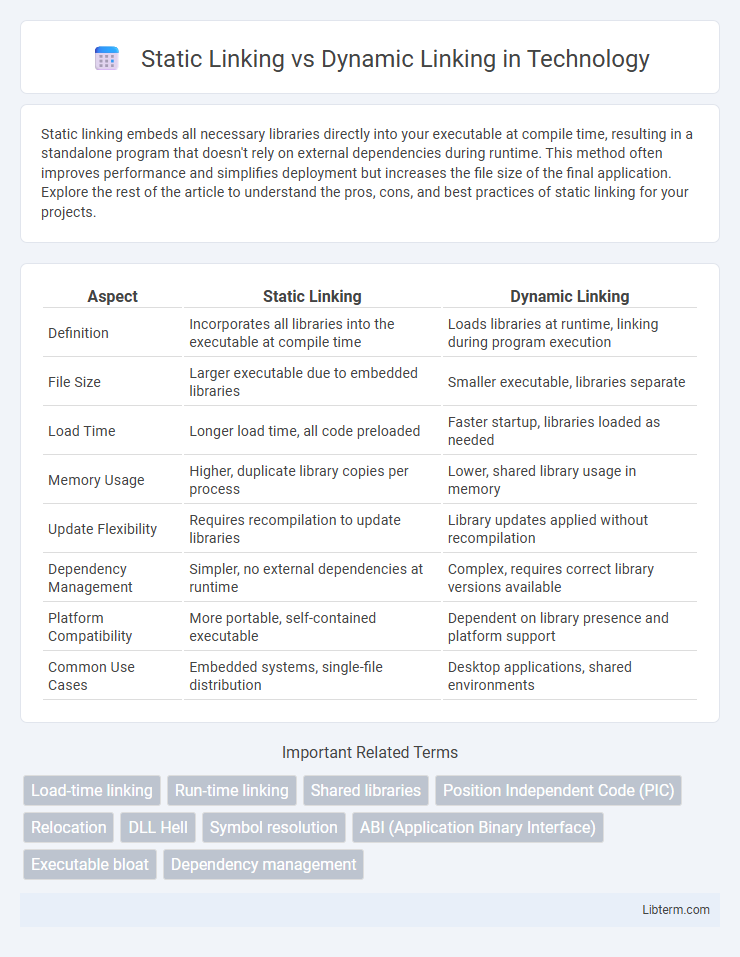Static linking embeds all necessary libraries directly into your executable at compile time, resulting in a standalone program that doesn't rely on external dependencies during runtime. This method often improves performance and simplifies deployment but increases the file size of the final application. Explore the rest of the article to understand the pros, cons, and best practices of static linking for your projects.
Table of Comparison
| Aspect | Static Linking | Dynamic Linking |
|---|---|---|
| Definition | Incorporates all libraries into the executable at compile time | Loads libraries at runtime, linking during program execution |
| File Size | Larger executable due to embedded libraries | Smaller executable, libraries separate |
| Load Time | Longer load time, all code preloaded | Faster startup, libraries loaded as needed |
| Memory Usage | Higher, duplicate library copies per process | Lower, shared library usage in memory |
| Update Flexibility | Requires recompilation to update libraries | Library updates applied without recompilation |
| Dependency Management | Simpler, no external dependencies at runtime | Complex, requires correct library versions available |
| Platform Compatibility | More portable, self-contained executable | Dependent on library presence and platform support |
| Common Use Cases | Embedded systems, single-file distribution | Desktop applications, shared environments |
Introduction to Linking in Software Development
Linking in software development involves combining various pieces of code and libraries into a single executable program. Static linking incorporates all library code directly into the executable at compile time, resulting in larger file sizes but faster startup times and independence from external dependencies. Dynamic linking loads libraries at runtime, enabling smaller executables, easier updates, and shared code usage among different programs, but introduces dependency on external files during execution.
What is Static Linking?
Static linking involves incorporating all library code directly into an executable during the compilation process, resulting in a standalone binary with no external dependencies. This approach increases the executable size but improves performance and portability by eliminating runtime loading of shared libraries. Static linking is commonly used in embedded systems and environments where predictable execution without external dependencies is critical.
What is Dynamic Linking?
Dynamic linking is a process where external libraries or modules are linked to a program at runtime rather than at compile time, enabling smaller executable sizes and easier updates. This method allows multiple programs to share common code in dynamic link libraries (DLLs) or shared objects, reducing memory usage and disk space. Dynamic linking enhances software modularity and facilitates seamless integration of updates and bug fixes without recompiling the entire application.
Key Differences Between Static and Dynamic Linking
Static linking incorporates all library code directly into the final executable, resulting in larger file sizes and faster execution since no external dependencies are needed at runtime. Dynamic linking loads shared libraries during program execution, reducing executable size and enabling memory sharing across processes but relying on the presence of external DLLs or shared objects. Key differences include static linking's fixed library versions versus dynamic linking's flexibility to update libraries independently without recompiling the application.
Advantages of Static Linking
Static linking embeds all library code directly into the executable, resulting in faster program startup and improved performance due to reduced runtime dependencies. It enhances portability by eliminating dependency on external libraries, ensuring the application runs consistently across different environments. Static linking also simplifies deployment and reduces potential runtime errors caused by missing or incompatible shared libraries.
Advantages of Dynamic Linking
Dynamic linking reduces an application's memory footprint by allowing multiple programs to share a single copy of a library, enhancing overall system efficiency. It facilitates easier updates and maintenance since library components can be replaced without recompiling dependent applications, improving security and functionality. This method also supports modular software design, enabling faster deployment and flexibility in software development environments.
Disadvantages of Static Linking
Static linking increases executable file size by embedding all library code, leading to higher memory usage and longer load times. It lacks flexibility since any updates or security patches to libraries require recompiling and redistributing the entire application. This method also limits code sharing across applications, resulting in inefficient use of system resources.
Disadvantages of Dynamic Linking
Dynamic linking can lead to runtime performance overhead due to the need for symbol resolution and library loading during program execution. It increases the risk of dependency issues such as "DLL Hell," where incompatible or missing shared libraries cause application failures. Security vulnerabilities arise from shared libraries being updated independently, potentially introducing untested changes or exploits that affect all dependent applications.
Use Cases and Best Practices for Linking Methods
Static linking is ideal for embedded systems and standalone applications where independence from external libraries ensures stability and faster load times, making it suitable for devices with limited storage or no internet connectivity. Dynamic linking is preferred in large-scale applications and operating systems, allowing multiple programs to share common libraries, which reduces memory usage and simplifies updates or patches. Best practices recommend static linking for critical or security-sensitive components to avoid runtime dependency issues, while dynamic linking should be used for modular applications requiring frequent library updates and reduced binary size.
Conclusion: Choosing the Right Linking Strategy
Choosing the right linking strategy depends on the specific application requirements, system environment, and performance goals. Static linking embeds all necessary libraries into the executable, ensuring faster startup times and simplified deployment but increasing binary size. Dynamic linking reduces memory usage and allows easier updates by sharing common libraries at runtime, making it ideal for large or frequently updated applications.
Static Linking Infographic

 libterm.com
libterm.com